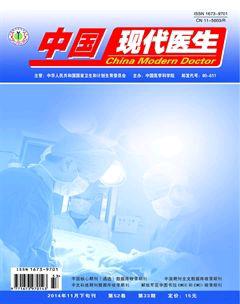血浆蛋白Z与颈动脉内膜中层厚度在急性冠脉综合征中的临床意义
唐斌等
[摘要] 目的 研究在急性冠脉综合征(ACS)中血浆蛋白Z(PZ)与颈动脉内膜中层厚度(IMT)的临床意义及其相关性。方法 筛选60例急性冠脉综合征患者(按照Gensini积分分为A、B、C三组),15例正常对照组受试者。采取静脉血以ELISA方法检查PZ浓度,彩色B超进行颈动脉IMT检查。 结果 与对照组相比,ACS 组PZ显著下降(P<0.05),颈动脉IMT上升(P<0.05)。在ACS组内,随着Gensini评分增高, PZ水平随Gensini积分的上升而下降,且组内间每两级之间均有显著性差异(P<0.05);而颈动脉IMT 则增加,组内每两级之间均有显著性差异(P<0.05)。结论 ACS的严重度可能与PZ水平与呈负相关,而与颈动脉IMT呈正相关,表示PZ水平下降可能是ACS的一个独立危险因素,IMT厚度增加可能加重ACS斑块的不稳定性,检测其水平可能有助于评估急性冠脉综合征的严重度。
[关键词] 急性冠脉综合征;血浆蛋白Z;颈动脉内膜中层厚度
[中图分类号] R587.2 [文献标识码] B [文章编号] 1673-9701(2014)33-0039-03
[Abstract] Objective To study the clinical significance and correlation of plasma protein Z and carotid artery intima-media thickness in patients with acute coronary syndrome. Methods Sixty acute coronary syndrome patients (according to the Gensini score were divided into A、B、C group), and 15 normal control subjects were recruited for this study. PZ levels were measured by enzyme linked immunosorbent assay, carotid IMTs were measured by B ultrasound measurement. Results Compared with the control group, PZ levels of ACS group significantly decreased (P<0.05),carotid artery IMTs significantly increased(P<0.05). In the ACS group, with the score of Gensini increased,PZ level decreased with the rising of Gensini score,and there were significant differences between each two groups(P<0.05);Carotid artery IMT increased with the rising of Gensini score,and there were significant differences between each two groups(P<0.05). Conclusion The ACS severity is negatively correlated with PZ level, but positively correlated with carotid IMT,which shown that the reduction of PZ levels may be an independent risk factor of ACS, increased IMT may increase ACS plaque instability. Combined detection of PZ and carotid artery IMT may have an important valve in severity of the acute coronary syndrome.
[Key words] Acute coronary syndrome;Plasma protein Z;Carotid artery intima-media thickness
急性冠脉综合征是对人类生命安全及健康造成严重危险的一种常见冠心病急危征,国内外研究表明其发生与冠状动脉粥样硬化斑块的不稳定明显相关。近年来研究显示PZ在ACS发生发展中的作用日益受到重视[1]。Selhub J等[2]研究表明颈动脉IMT可能与ACS的严重度之间存在明显相关性,可能是冠状动脉发生粥样硬化的早期表现之一。本文现拟就ACS与PZ、颈动脉IMT的相关性进行研究,并且讨论其临床意义。
1 资料与方法
1.1 临床资料
病例筛选:UA诊断参照2000年中华医学会建议的标准[3],AMI诊断参照2001年中华医学会AMI诊断和治疗指南[4];CAG阳性:CAG采用Judkins法,多角度行左、右CAG,至少一支主要血管狭窄程度≥50%为阳性,ACS患者组内依照Gensini评分系统进行级别区分,按积分计算分为A(G≤30)、B (30
1.2 方法
1.2.1 PZ测定 ACS组病例在急性起病期2 h内采取外周静脉血,正常对照组于第2日早晨空腹采取外周静脉血;留取20 mL分别缓慢注入10 mL于肝素抗凝离心管、5 mL加入含乙二胺四乙酸二钠的塑料试管及5 mL于普通管中,摇匀后进行离心4 min,转速3 000 r/min留取上层清液,-80℃冰箱储存待测。所有标本收集后一批次检测,以此尽可能避免批间误差和测量误差。PZ检测:实验前取出冰冻标本行快速复融,所有样本按照试剂盒与仪器使用说明书进行检测。
1.2.2 IMT测定 彩超机:日本东芝公司6000型,频率7.5 MHz。受试者采取平卧头后仰位,头部充分放松偏向对侧,由经验丰富的超声医师专人测量。反复测定3次双侧颈内动脉及其分叉部、颈总动脉,观察内膜中层厚度,计算平均值[5]。
1.3 统计学分析
采用SPSS 12.0软件进行统计分析,以均数±标准差(x±s)表示;组间比较行方差分析,齐则采用t检验,Pearson 积差相关;不齐则采用秩和检验,Spearman 秩相关。两两比较采用Bonferroni方法。以P<0.05为差异有统计学意义。
3 讨论
众多国内外资料报道PZ是主要由肝脏合成分泌的一种维生素K依赖的单链糖蛋白,研究表明在Ca2+的参与下,PZ可在磷脂表面与FXa形成复合物并作为ZPI 的辅助因子在磷脂表面结合快速抑制FXa的活性[6],可提升ZPI活性近1000 倍,间接发挥抗凝作用[7]。Fedi等[8]报道,通过比较研究223例ACS患者和265例健康对照组发现,ACS患者PZ水平明显降低(P<0.01),发现PZ水平低于565 ng/mL时与ACS明显相关,据此得出结论认为PZ缺乏是ACS的独立发生因素。Sofi F等[10]研究也认为PZ缺乏是ACS的独立危险因素,其在2006年报道一随访研究,其关于对ACS患者进行为期1年PZ水平的随访,结果显示随访1年后血浆PZ水平在比入院时明显下降,且发现入院时血浆PZ水平<609.3 ng/mL,其发生主要不良心脏事件(Major adverse cardiacevents;MACE)为19.5%,但是在未发生MACE的患者中比例为7.9%,研究结果显示入院时1年后不良心脏事件与入院时低PZ水平存在明显相关性,另外从急性期到恢复期PZ水平逐渐下降。国内学者潘学谊等[10]通过研究比较40例AMI患者与60名健康对照者的PZ水平(1071.44±180.52 μg/L VS 2257.97±479.76 μg/L),发现相似的现象,AMI组PZ水平明显降低(P<0.01)。Greten J[11]等运用免疫组化方法对18例动脉血栓性疾病患者进行研究,结果显示其大血管内皮细胞及粥样斑块中均有PZ沉积,与之相对应的是在正常对照组的血管内皮下结构及微血管内皮细胞中没有找到PZ沉积的证据,据此Greten J认为PZ可能与动脉粥样硬化损伤及斑块的不稳定性存在一定关系。本研究结果显示:与正常对照组比较,ACS 组PZ水平显著下降(P<0.05),并且随着Gensini积分增加,其PZ水平下降且每两级间均有显著性差异(P<0.05),表明ACS风险与PZ水平关联,这与国内外前期相关研究结果一致。
近年来国内外研究报道,在冠状动脉和颈动脉二者发生动脉硬化的进程中存在某种内在的共同机制,二者的发生显著相关性[12,13],颈动脉病变及其内膜中层厚度为预测冠心病或其他血管栓塞性疾病存在及严重性的独立危险性指标,另外由于具有众多优点,颈动脉超声是目前用于评估冠状动脉粥样病变程度的常用手段之一[14]。赵平等[15]对122例临床患者进行超声检测发现,颈动脉超声检测可以早期预测冠状动脉粥样硬化,更可方便及时地检测出颈动脉粥样硬化病变。然而关于颈动脉IMT预测评估ACS的严重度的报道比较少见。因此我们开展了这一研究,我们经彩超测量了60例ACS患者的颈动脉IMT,并与正常对照组比较发现,ACS 组颈动脉IMT上升,且随着Gensini积分增加,颈动脉IMT增加,组内每两级之间均有显著性差异(P<0.05)。且颈动脉IMT与ACS患者Gensini积分呈正相关关系(P<0.01)。
综上所述,PZ水平降低预示ACS的风险性增加,乃ACS发生发展的一个独立的危险因素。颈动脉IMT增加预示ACS的严重性增加,为ACS的一个早期预测指标,联合检测PZ水平及颈动脉IMT值将有助于预示和判断ACS。
[参考文献]
[1] Almawi WY,Al-Shaikh FS,Melemedjian OK,et al. Protein Z,an anticoagulant protein with expanding role in reproductive biology[J]. Reproduction,2013,146(2):R73-80.
[2] Selhub J,Angelo A. Relationship between homocyateine and thrombotic disease[J]. Am J Med Sei,2008,316(2):129-135.
[3] 中华医学会心血管病学分会《中华心血管病杂志》编辑委员会. 不稳定型心绞痛诊断和治疗建议[J]. 中华心血管病杂志,2000,28(6):409-412.
[4] 中华医学会心血管病学分会《中华心血管病杂志》编辑委员会,《中国循环杂志》编辑委员会,急性心肌梗死诊断和治疗指南[J]. 中华心血管病杂志,2001,29(12):710-725.
[5] 李英,王娜,王海滨,等. 不同危险分层急性冠脉综合征患者颈动脉血管病变程度研究[J]. 河北医药,2014,36(18):2803-2805.
[6] Huang X,Yan Y,Tu Y,et al. Structural basis for catalytic activation of protein Z-dependent protease inhibitor (ZPI) by protein Z[J]. Blood,2012,120(8):1726-1733.
[7] Choi Q,Kim JE,Hyun J,et al. Contributions of procoagulants and anticoagulants to the international normalized ratio and thrombin generation assay in patients treated with warfarin: potential role of protein Z as a powerful determinant of coagulation assays[J]. Thromb Res,2013,132(1):e70-75.
[8] Fedi S,Sofi F,Brogi D,et al. Low protein Z plasma levels are independently associated with acute coronary syndromes[J]. Thromb Haemost,2003,90(6):1173-1178.
[9] Sofi F,Cesari F,Marcucci R,et al. Protein Z levels and prognosis in patients with acute coronary syndromes[J].Clin Chem Lab Med,2006,44(9):1098-1102.
[10] 潘学谊,丁彩屏,钟亮伊,等. 蛋白质Z检测在心脑血管疾病中的临床意义[J]. 中华血液学杂志,2004,11(25):671-674.
[11] Greten J,Kreis I,Liliemiek B,et al. Localisation of protein Z in vascular lesions of patients with atherosclerosis[J].Vasa,1998,27(3):144-148.
[12] 朱英,邓又斌,刘娅妮,等. 超声造影对颈动脉斑块新生血管密度与冠状动脉粥样硬化性心脏病相关性的评价[J]. 中华医学超声杂志(电子版),2014,10(9):741-745.
[13] Ahmadvazir S,Zacharias K,Shah BN,et al. Role of simultaneous carotid ultrasound in patients undergoing stress echocardiography for assessment of chest pain with no previous history of coronary artery disease[J]. Am Heart J,2014,168(2):229-236.
[14] Ikeda N,Araki T,Sugi K,et al.Ankle-brachial index and its link to automated carotid ultrasound measurement of intima-media thickness variability in 500 Japanese coronary artery disease patients[J]. Curr Atheroscler Rep,2014, 16(3):393.
[15] 赵平,常培叶,刘喜,等. 颈动脉超声检查预测冠状动脉硬化的价值[J]. 心血管康复医学杂志,2013,22(1):71-73.
(收稿日期:2014-09-26)
[6] Huang X,Yan Y,Tu Y,et al. Structural basis for catalytic activation of protein Z-dependent protease inhibitor (ZPI) by protein Z[J]. Blood,2012,120(8):1726-1733.
[7] Choi Q,Kim JE,Hyun J,et al. Contributions of procoagulants and anticoagulants to the international normalized ratio and thrombin generation assay in patients treated with warfarin: potential role of protein Z as a powerful determinant of coagulation assays[J]. Thromb Res,2013,132(1):e70-75.
[8] Fedi S,Sofi F,Brogi D,et al. Low protein Z plasma levels are independently associated with acute coronary syndromes[J]. Thromb Haemost,2003,90(6):1173-1178.
[9] Sofi F,Cesari F,Marcucci R,et al. Protein Z levels and prognosis in patients with acute coronary syndromes[J].Clin Chem Lab Med,2006,44(9):1098-1102.
[10] 潘学谊,丁彩屏,钟亮伊,等. 蛋白质Z检测在心脑血管疾病中的临床意义[J]. 中华血液学杂志,2004,11(25):671-674.
[11] Greten J,Kreis I,Liliemiek B,et al. Localisation of protein Z in vascular lesions of patients with atherosclerosis[J].Vasa,1998,27(3):144-148.
[12] 朱英,邓又斌,刘娅妮,等. 超声造影对颈动脉斑块新生血管密度与冠状动脉粥样硬化性心脏病相关性的评价[J]. 中华医学超声杂志(电子版),2014,10(9):741-745.
[13] Ahmadvazir S,Zacharias K,Shah BN,et al. Role of simultaneous carotid ultrasound in patients undergoing stress echocardiography for assessment of chest pain with no previous history of coronary artery disease[J]. Am Heart J,2014,168(2):229-236.
[14] Ikeda N,Araki T,Sugi K,et al.Ankle-brachial index and its link to automated carotid ultrasound measurement of intima-media thickness variability in 500 Japanese coronary artery disease patients[J]. Curr Atheroscler Rep,2014, 16(3):393.
[15] 赵平,常培叶,刘喜,等. 颈动脉超声检查预测冠状动脉硬化的价值[J]. 心血管康复医学杂志,2013,22(1):71-73.
(收稿日期:2014-09-26)
[6] Huang X,Yan Y,Tu Y,et al. Structural basis for catalytic activation of protein Z-dependent protease inhibitor (ZPI) by protein Z[J]. Blood,2012,120(8):1726-1733.
[7] Choi Q,Kim JE,Hyun J,et al. Contributions of procoagulants and anticoagulants to the international normalized ratio and thrombin generation assay in patients treated with warfarin: potential role of protein Z as a powerful determinant of coagulation assays[J]. Thromb Res,2013,132(1):e70-75.
[8] Fedi S,Sofi F,Brogi D,et al. Low protein Z plasma levels are independently associated with acute coronary syndromes[J]. Thromb Haemost,2003,90(6):1173-1178.
[9] Sofi F,Cesari F,Marcucci R,et al. Protein Z levels and prognosis in patients with acute coronary syndromes[J].Clin Chem Lab Med,2006,44(9):1098-1102.
[10] 潘学谊,丁彩屏,钟亮伊,等. 蛋白质Z检测在心脑血管疾病中的临床意义[J]. 中华血液学杂志,2004,11(25):671-674.
[11] Greten J,Kreis I,Liliemiek B,et al. Localisation of protein Z in vascular lesions of patients with atherosclerosis[J].Vasa,1998,27(3):144-148.
[12] 朱英,邓又斌,刘娅妮,等. 超声造影对颈动脉斑块新生血管密度与冠状动脉粥样硬化性心脏病相关性的评价[J]. 中华医学超声杂志(电子版),2014,10(9):741-745.
[13] Ahmadvazir S,Zacharias K,Shah BN,et al. Role of simultaneous carotid ultrasound in patients undergoing stress echocardiography for assessment of chest pain with no previous history of coronary artery disease[J]. Am Heart J,2014,168(2):229-236.
[14] Ikeda N,Araki T,Sugi K,et al.Ankle-brachial index and its link to automated carotid ultrasound measurement of intima-media thickness variability in 500 Japanese coronary artery disease patients[J]. Curr Atheroscler Rep,2014, 16(3):393.
[15] 赵平,常培叶,刘喜,等. 颈动脉超声检查预测冠状动脉硬化的价值[J]. 心血管康复医学杂志,2013,22(1):71-73.
(收稿日期:2014-09-26)

